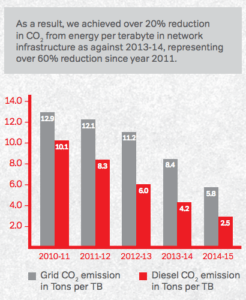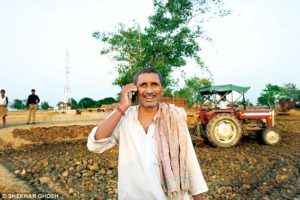Climate Calling! Airtel India and ICT in the Age of Global Warming

Airtel India is adapting to the business impact of climate change on ICT in a billion-person economy. In emerging markets, is it possible to balance the opposing goals of increasing access to technology while reducing emissions?
 In our parents’ and grandparents’ generations, the essentials were food, clothing, and shelter – or in Hindi, “roti, kapda, aur makan.” Today, we add a fourth: the mobile phone.
In our parents’ and grandparents’ generations, the essentials were food, clothing, and shelter – or in Hindi, “roti, kapda, aur makan.” Today, we add a fourth: the mobile phone.
Mobile phones, and with them, the ability constantly communicate with the world, have experienced explosive growth. As of January 2016 there are over 7 billion mobile connections in the world, of which 1 billion are in India.1,2 Yet constant information sharing does not come without cost. In 2008, The Climate Group and McKinsey released a study that found the ICT sector’s emissions currently comprise 2-2.5% of total global GHG emissions and are expected to nearly triple by 2020.3 The good news is that by increasing energy efficiency and enabling efficiency in other sectors, the ICT sector has the potential to deliver carbon savings equal to five times this amount by 2020.
Airtel, India’s largest mobile network, serves over 240 million customers in the country. Subscribership and usage have skyrocketed: from FY2013-14 to FY2014-15, data usage on the network increased by 55%.4 Airtel’s operating model is significantly affected by climate change in three overarching ways: Operational cost, Business continuity, and User capacity.
Addressing operational cost: reducing dependence on GHGs. Over 80% of an average mobile operator’s energy usage is derived from operating the network.5 As usage rises, cost and source of energy are a major concerns for the continuity of the business.
Airtel has developed several approaches to reduce its network infrastructure’s energy usage. First, it has converted thousands of sites from indoor to outdoor, eliminating the need for constant cooling, and lowering energy consumption by ~25%. The company also piloted micro-cooling and cold aisle containment systems that reduce the need for air-conditioning even in indoor sites.
Additionally, the company is migrating to renewable energy sources to reduce dependence on diesel and other GHGs. In FY2014-15, Airtel installed six solar plants expected to reduce emissions by 800 tons/year and over 200 new hybrid sites expected to reduce emissions by 3800 tons/year.
In 2013-14, Airtel achieved a 20% annual reduction in CO2 emissions per terabyte of data in its network infrastructure, the third year in a row of 20% reduction.4,6
Ensuring business continuity: building flexibility into infrastructure. Extreme climate events increasingly pose business risk to Airtel, whose operations depend entirely on their network systems’ abilities to maintain continuity. During floods in Kashmir, Airtel’s networks were disrupted due to a lack of contingency systems. They worked with industry body COAI (Cellular Operators Association of India) to develop a plan to share tower infrastructure with competitor mobile networks. A highly unusual agreement across global markets, it has now expanded to include most of India’s mobile networks and enables the entire system to function more reliably in the face of potential adverse events.7,8
Supporting user capacity: providing services that enable adaptation. Both gradual degradation of environments and increased extreme weather events have the potential to disrupt consumer usage of and ability to pay for Airtel services, a critical risk for the firm.
In terms of environmental degradation, nearly 50% of India’s population works in agriculture and over 40% of Airtel mobile subscribers are rural.4,8 Airtel’s ISKL initiative, a JV with the world’s largest fertilizer cooperative, IFFCO, provides farmers with information on weather forecasting, commodity prices, agronomy, dairy farming, and forestry to help them make timely decisions at a fraction of traditional cost, mitigating against the risk of crop and financial ruin.
In the event of an acute climate shock, consumers may not have access to cash to purchase talktime. Airtel Money partnered with Kotak Mahindra Bank to extend mobile credit in times of need. In a crisis, mobile alerts can also help save lives by sharing real-time information. With the Government of Odisha, Airtel added 200,000 fishermen to the network to provide lifesaving alerts during cyclones, floods, and other events.4, 6
Looking forward. By 2018, Airtel aims to reduce CO2 emissions from network infrastructure by 70% per unit while increasing broadband coverage.4 First, Airtel should design incentivizes to identify radical innovations in network infrastructure. As rural systems become increasingly sparse and urban systems increasingly dense, the traditional tower model may no longer be effective. Second, data sharing and analytics is still limited. Each provider seeks to maintain control over their own proprietary information. However, additional efficiency and cost savings may be realized by sharing data that could help providers detect and respond to gradual shifts in climate or acute weather events. Helping to establish a ‘public good’ information sharing system through the industry could be a next step for Airtel as the market leader.
As population and incomes rise, the tension between access and environmental impact increases. Addressing this tension will require innovation beyond the company’s existing efforts. Is it possible to balance the opposing goals of increasing access to technology while reducing global emissions? (Word count: 798)
[3] Smart 2020: Enabling the Low Carbon Economy in the Information Age. http://gesi.org/files/Reports/Smart%202020%20report%20in%20English.pdf.
[4] Airtel India Sustainability Report 2015. http://www.airtel.in/sustainability-file/common/files/Airtel%20CSR%202016_web.pdf.
[5] Environmental Impact of Mobile Communications Networks. http://www.gsma.com/publicpolicy/wp-content/uploads/2012/04/environmobilenetworks.pdf.
[6] Airtel India Sustainability Report 2011-12. http://www.airtel.in/sustainabilitypdf/sustainabilityreport.pdf
[7] Interview with Airtel India, January 2014.
[8] https://www.bharti-infratel.com/cps-portal/web/web/RelianceJIO.html.
[9] CIA World Factbook. https://www.cia.gov/library/publications/the-world-factbook//fields/2048.html.





This was an incredibly interesting read as I was not aware of the extent to which Airtel was investing in sustainability as part of its strategy. Their approach towards integrating sustainability into their core business model looks to be very well executed and covers not only the reduction of the carbon footprint within their own value chain but also extends to supporting and empowering the communities that they serve to better adapt to climate change, which is a key differentiator. Airtel’s programs around farmer empowerment and using mobile technology to deliver real-time weather, farming knowledge or natural disaster alerts to rural consumers, allowing them to adapt to and succesfully mitigate the risks of climate change is exemplary.
Something additional that I found incredibly interesting about Airtel’s sustainability strategy was also their adoption of digital avenues to further cut down dependency on natural resources such as paper. In emerging markets, mobile phone telecommunications is still a paper-heavy business with all bills for post-paid users or the recharge vouchers for pre-paid users still being physical. Through the recent years, Airtel has converted a large cross section of their consumers to paperless billing and through that, saved close to 700 mn sheets of paper. They are also constantly looking to innovate in terms of product design and have teams looking into reducing packaging costs by altering SIM sizes to reduce the amount of plastic required or finding digital replacements for the recharge vouchers. They have also been looking into e-waste management, by collecting, re-using and re-cycling their used hardware and donating them to underprivileged schools they that help support. While these are probably small steps compared to the larger initiatives they are undertaking which you highlight above, I feel like Airtel’s sustainability is a multi-faceted one, that seems to have considered and included all aspects of their value chain and the lives of the consumers that they touch and will prove to be a strategic completive advantage to their growth as a company.
This was a very informative post about a topic that I knew little about beforehand. I was surprised to learn that Airtel could reduce costs and emissions by switching from indoor to outdoor network facilities. Is this capability limited to certain regions and climates that are more temperate? I would imagine that there could be network outages for outdoor facilities from intense heat during the summer. Also, I am curious to know how Airtel’s emissions compare to similar service providers, especially in developed countries. While Airtel has managed to reduce emissions by over 20% in the past three years, that number becomes less impressive if they started from a much higher emissions figure relative to other companies. That said, I hope that they continue their pattern of emissions reductions and are able to achieve their target of a 70% reduction by 2018.
Really fascinating to learn about the role that Airtel has played in environmental protection in India, particularly in the context of farming. I wonder if the kind of real-time information that Airtel is able to provide farmers on commodity prices can be extended to other industries and geographies as well. I can definitely see the value of a telco adopting similar services in Indonesia for example, where farmers are vulnerable to similar commodity price fluctuations or may require special assistance during tsunamis, earthquakes, floods and other natural disasters (disasters that are in fact frequently tied to the effects of climate change). Perhaps Airtel can consider expanding these initiatives on a global scale, partnering with telco’s across emerging markets and spreading their best practice knowledge in these areas.
Great post! I loved getting a deeper understanding of how mobile networks and access to them can be directly correlated to helping mitigate climate change, a link that is powerful and also not very intuitive. The question that you pose at the end is exactly spot-on: is it possible to increase access to accommodate growth in population while reducing effects on climate? These are the questions the our generation will have to solve in order to avoid serious consequences of global climate change.
Thank you for sharing this post Sanchali – I was unaware of the dramatic impact that maintaining a phone network has on our environment. From my experience in India, I have learned that it is extremely challenging to drive people and organizations towards sustainability. It both inspiring and beacon of hope to see that one of the largest and oldest telecom organizations in India is taking such measures to curb energy needs.
Fascinating read. It’s interesting that they’re able to reduce CO2 emissions every year by 20% per terabyte of data. With the amount of data being shared over mobile networks increasing exponentially, I do wonder if the sheer amount of data is increasing by more than 20%, leading to net increase in emissions.
By virtue of being the market leader, I think Airtel is in a unique position to define industry best practices around sustainable tower design, more improved tower location and the power mix provided to towers. Given the long term cost savings this will yield, this should also hopefully align with their operating model.